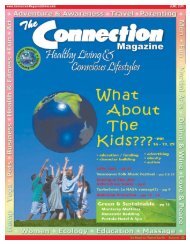Mar 08.qxd - Connection Magazine
Mar 08.qxd - Connection Magazine
Mar 08.qxd - Connection Magazine
You also want an ePaper? Increase the reach of your titles
YUMPU automatically turns print PDFs into web optimized ePapers that Google loves.
y Dr. Joseph Mercola<br />
A<br />
report was presented at the<br />
annual Pediatric Academic<br />
Society meeting describing<br />
how a preschool-age girl and her kindergarten-age<br />
brother began growing<br />
pubic hair.<br />
This was not an isolated case;<br />
in 2004, there was similar cluster of<br />
fi ve children, and previous clusters in<br />
outbreaks occurring along the lines of<br />
disease epidemics or environmental<br />
poisonings.<br />
In 1979, there was an outbreak<br />
of breast enlargement among hundreds<br />
of Italian schoolchildren, most likely<br />
caused by estrogen contamination of<br />
Voted the Valley’s<br />
Favorite Pizzeria<br />
& Best Value.<br />
Locally Owned!<br />
www.redwoodpizza.com<br />
ALL PIZZAS NOW MADE WITH<br />
ORGANIC DOUGH & SAUCE<br />
Monday: Dine-In Pizza Specials!<br />
Homemade Organic Lasagna + Salads<br />
Happy Hours: Weekdays 4 - 6 pm<br />
Wednesdays ‘til 9<br />
Party Room<br />
with Foosball,<br />
Pinball and TV.<br />
Limit one coupon per order<br />
1 Topping FREE on any Pizza!<br />
www.redwoodpizza.com<br />
335-1500<br />
6205 Hwy 9 Felton • Across from Felton Community Hall<br />
Lunch<br />
FRI. - SUN.<br />
Dr. Mercola Addresses:<br />
Why Are Kids Entering Puberty<br />
Before They Enter School?<br />
beef and poultry.<br />
Most commonly, these outbreaks<br />
traced to accidental drug exposures.<br />
But some physicians worry<br />
that children are at higher risk of early<br />
puberty due to the increasing availability<br />
of classes of drugs, cosmetics<br />
and environmental contaminants called<br />
endocrine disruptors.<br />
In the case of the two children<br />
described in the report, their testosterone<br />
level was nearly 100 times the<br />
normal amount. The cause was traced to<br />
a concentrated testosterone skin cream<br />
being used by their father. The children<br />
absorbed the testosterone through normal<br />
skin contact with their father.<br />
Closed<br />
Tuesdays<br />
Sex hormones like testosterone<br />
are particularly potent because they<br />
are easily absorbed through the skin<br />
and resist degradation. Other known<br />
triggers of early puberty have included<br />
a shampoo that contained estrogen and<br />
placental extract, shampoos containing<br />
lavender and tea tree oils, and industrial<br />
pollutants.<br />
—New York Times Oct. 17,<br />
2006 Spartanburg Herald-Journal,<br />
Oct. 17, 2006<br />
Dr. Mercola’s Comment:<br />
It’s about time medical “experts”<br />
are finally recognizing the growing<br />
number of health problems resulting<br />
from contact with toxic chemicals.<br />
It is shocking, but nevertheless,<br />
increasingly common for fi ve and six<br />
year old children to go through precocious<br />
puberty. The signs of which<br />
include:<br />
For girls before age 8:<br />
• Breasts<br />
by Joe Wilkes<br />
Editor’s Note: Last month,<br />
we presented 3 of the 9 foods. This<br />
issue we present 2 more undesirable<br />
foods and their ‘good’ alternatives.<br />
We will continue each month until<br />
we complete the list.<br />
If you’ve followed the news on<br />
childhood obesity lately, you know<br />
that the state of affairs is pretty<br />
grim. Childhood obesity rates have<br />
tripled over the past two decades, and<br />
most signs show that today’s children<br />
will be the fi rst to have shorter life<br />
expectancies than their parents. Much<br />
of the blame for this has deservedly<br />
been laid at the feet of the producers<br />
and marketers of unhealthy food aimed<br />
at our youngest consumers. These<br />
producers and marketers have created<br />
an uphill battle for parents trying to<br />
compete with superheroes and cartoon<br />
animals for their children’s palates and<br />
stomachs.<br />
4). JUICE and JUICE-FLAVORED<br />
DRINKS:<br />
Juice, what could be wrong with<br />
juice? While 100% juice is a good<br />
source of vitamin C, it doesn’t have<br />
the fi ber of whole fruit, and provides<br />
calories mostly from sugar and carbohydrates.<br />
Too much juice can lead to<br />
obesity and tooth decay, among other<br />
• Armpit or pubic hair<br />
• First menstruation<br />
For boys before age 9:<br />
• Enlarged testicles and penis<br />
• Armpit or pubic hair<br />
• Facial hair<br />
Another is accidental contact<br />
with endocrine disruptors present in<br />
many household products and cosmetics,<br />
including:<br />
• Bovine growth hormones commonly<br />
added to commercial dairy<br />
• Soy products which are loaded with<br />
hormone like substances<br />
• Bisphenol A, commonly used in many<br />
plastics<br />
• Phthalates also commonly used in<br />
plastics<br />
• Perfluorooctanoic acid (PFOA)<br />
— better known as Tefl on<br />
The disruption of your hormone<br />
system, and all of the consequences<br />
resulting from it, is a typical way<br />
that environmental toxins negatively<br />
impact your body.<br />
No surprise, Congress told<br />
the EPA to develop a comprehensive<br />
screening program within three years<br />
a decade ago. The agency never got<br />
around to it, however, due to efforts<br />
to squash it by representatives from<br />
the chemical industry serving on a<br />
program committee.<br />
Page 22 ▲ The <strong>Connection</strong> <strong>Magazine</strong> ▲ www.theConnect.com ▲ <strong>Mar</strong>ch — April 2, 2008<br />
If you have children, this is<br />
clearly something you will want to<br />
avoid. Here are some measures you<br />
can take to protect you and your children<br />
from common toxic substances<br />
which will cause them to go into puberty<br />
more than a decade before they<br />
were designed to:<br />
• Store your food in glass containers<br />
whenever possible, as it is the most<br />
inert container you can use.<br />
• Only use natural cleaning products<br />
in your home. Most health food stores<br />
will have these available, or you can<br />
search online for them.<br />
• Buy and eat, as much as possible,<br />
organic foods, especially milk which is<br />
frequently contaminated with bovine<br />
growth hormone.<br />
• Avoid processed foods.<br />
• Switch to natural brands of toiletries,<br />
including shampoo, toothpaste,<br />
antiperspirants and cosmetics. Same<br />
sources as above for these, either your<br />
local health food store, or you can<br />
search online.<br />
• Read Our Stolen Future by Theo<br />
Colborn, Dianne Dumanoski & John<br />
Peter Meyers<br />
For more information, visit<br />
www.mercola.com.<br />
Printed with permission.<br />
9 Foods Not to Give Kids<br />
problems. The American Academy<br />
of Pediatrics suggests 4 to 6 ounces<br />
of juice per day for kids under 6, and<br />
8 to 12 ounces for older kids. Juice<br />
drinks that aren’t 100% juice are usually<br />
laced with artifi cial colors and<br />
that old standby, HFCS, and should<br />
be avoided. Your best bet is to make<br />
your own juice from fresh, seasonal<br />
fruit. You won’t have to worry about<br />
all the additives, and it’s another way<br />
you can involve your kids in the cooking<br />
process. Let them design their own<br />
juice “cocktail.” And if you were even<br />
considering soda, perhaps a refresher<br />
course from Steve Edwards’ Nutrition<br />
911 series is in order (see “Nutrition<br />
911, Part VI: The Worst Food on the<br />
Planet” at www.steveedwardsonline.<br />
com).<br />
INSTEAD: Water is still the best<br />
thirst quencher. Explain the importance<br />
of good hydration to your kids,<br />
and set a good example yourself by<br />
carrying around a water bottle. Get<br />
them used to carrying a small bottle<br />
of water in their backpack or attached<br />
to their bike. If they’re very water<br />
averse, try water with a splash of fruit<br />
juice in it. But just a splash. The idea<br />
is to get kids used to not having things<br />
be overly sweet, overly salty, or overly<br />
fatty. The other great beverage is milk.<br />
Filled with nutrients, calcium, and<br />
protein, growing kids need plenty of<br />
milk, though not so much fat. Choosing<br />
low-fat or skim milk will help<br />
ensure that they get their milk without<br />
becoming a cow.<br />
5). FRENCH FRIES:<br />
High in calories, high in fat, and<br />
high in sodium˜and unsurprisingly,<br />
the most popular “vegetable” among<br />
kids. They offer virtually none of the<br />
nutrients found in broccoli, carrots,<br />
spinach, or other veggies not found in<br />
a deep fryer. And the fat they’re fried<br />
in is usually trans fat, the unhealthiest<br />
kind for the heart. To top it all off,<br />
studies are beginning to show cancercausing<br />
properties from acrylamide,<br />
a toxic substance that is created when<br />
starchy foods like potatoes are heated<br />
to extreme temperatures. In some tests,<br />
the amount of acrylamide in French<br />
fries was 300 to 600 times higher than<br />
the amount that the Environmental<br />
Protection Agency (EPA) allows in a<br />
glass of water.2<br />
INSTEAD: Vegetables like baby<br />
carrots, celery sticks, or other crudités<br />
are great options, but if potatoes must<br />
be had, there are some options that<br />
don’t begin with melting a brick of<br />
fat. A scooped-out potato skin with<br />
low-fat chili and a little cheese can<br />
provide lots of fi -<br />
ber and vitamins,<br />
with even higher<br />
amounts if the<br />
chili has beans.<br />
You can also try<br />
making baked<br />
fries, using slices<br />
of potato with a<br />
light brushing<br />
of olive oil. Or,<br />
the classic baked<br />
potato could be a<br />
hit, with yogurt<br />
dip or cottage<br />
cheese instead of<br />
sour cream and<br />
butter.<br />
Printed with<br />
permission.





